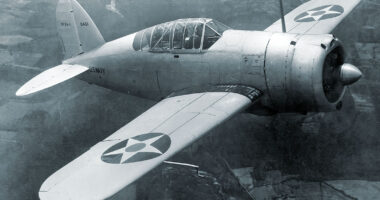Fifteen years ago, the British Second World War Memorial in London unveiled a new blue and white parachute, which it said was a replica of a second poppy that fell into the hands of the Allies. In reality, however, the parachute had been created from a hot-pink parachute that had been part of the German war effort during World War II. According to British firm Park Airways, who designed the parachute, the design was chosen after the original design created by the British firm of Fairey was rejected.
When the Battle of Britain was raging in World War II, the British Royal Air Force (RAF) flew a very special plane at its peak. It was a fast and dangerous aircraft to keep pace with the Luftwaffe, but it was also a special plane that had a dark side. It was the Avro Lancaster, affectionately known as the “Lanc.”
During World War II the United Kingdom was unable to keep its soldiers supplied with parachutes. This meant that they were often left without a way to slow their downward descent, and in some conditions they could be killed upon landing. So, the government came up with a solution in the form of pink parachutes, which symbolized Britain’s commitment to aiding its troops.
The illuminated souvenir belonged to a member of the Army Air Corps who survived the attack on Pearl Harbor.
I have a parachute that belonged to my father, Jack M. Spangler. He was an aircraft mechanic at Wheeler Field on Oahu when Pearl Harbor was bombed. I don’t know where or when he bought this parachute, but it looks like a cargo parachute. It’s bright pink (and I mean bright!). Appears never to have been used; straps and clamps still wrapped in paper. Any information on its history would be greatly appreciated.
–Julie Sallaz, Bangor, Michigan,
The object in question is undoubtedly a cargo parachute. During World War II, the U.S. Army not only developed the equipment needed to transport paratroopers to the front lines, but also to supply them during combat. Eventually, the Army introduced cargo parachutes in four sizes, designed to fit a variety of cargo sizes and available in five colors: red, green, yellow, blue and natural. The cargo was packed in different coloured parachutes for easy identification in the drop zone; local commanders decided which colours should be used. Cargo parachutes could be dropped from racks hanging under the belly of the aircraft or pushed through the cargo door. The Army has also developed eight standard containers for dropping supplies and equipment.
Jack M. Spangler (thanks to Julee Sallaz)
During the war, air deliveries repeatedly played a decisive role. On D-Day, parties of equipment with mortars, machine guns and bazookas were dropped with the paratroopers. And like the paratroopers, the bundles of equipment were widely dispersed; their recovery was a crucial weapon in the early battles of the Normandy campaign. For example, paratroopers dropped by mistake on the French village of Grenes were able to stubbornly defend themselves after the inhabitants retrieved bundles of supplies and equipment from the flooded areas.
Probably the most important air supply attempt was Operation Market Garden in 1944 in the Netherlands. The inability of air and ground forces to link up as planned made on-the-spot supply crucial. And unfortunately this has become almost impossible due to the capture and occupation of the landing zones by enemy forces.
As for the shocking color of this parachute, it’s not as unusual as it seems. The transition from red to pink is a factor of age, but the important thing is that the parachute is clearly visible. This parachute is probably even shinier because it has been in storage since it was made. ✯
-Tom Czekanski, Senior Curator and Head of Conservation, National World War II Museum.
Do you have a World War II object that you cannot identify?
Write the following at Footlocker@historynet.com :
– Your connection to the subject and what you know about it.
– The size of the object in inches.
– Multiple high resolution digital photographs taken up close and from different angles
.
– Photos must be in color and have a resolution of at least 300 dpi.
Unfortunately, it is not possible for us to respond to every request and estimate the costs.
This article was published in the April 2023 issue of World War II Magazine.During the war, the Nazis favored aircraft that were both hard to spot and hard to shoot down. They developed the concept of the “Hawk” and “Wulf” fighter planes, which were designed with a combination of the hardest and most aerodynamic shape possible. One of these planes was the Hs126. The Hs126 was a single-seat monoplane fighter-bomber with a rounded nose and a distinctive, bat-wing-like shape. What makes it so unusual is that it is a “reconnaissance aircraft”, as it was designed to take photos and collect information.. Read more about why did ww2 start and let us know what you think.
Related Tags:
ww2 parachutesparachuteswhy did world war 2 startparachute for salewhy did ww2 start,People also search for,Privacy settings,How Search works,ww2 parachutes,parachutes,why did world war 2 start,parachute for sale,why did ww2 start

